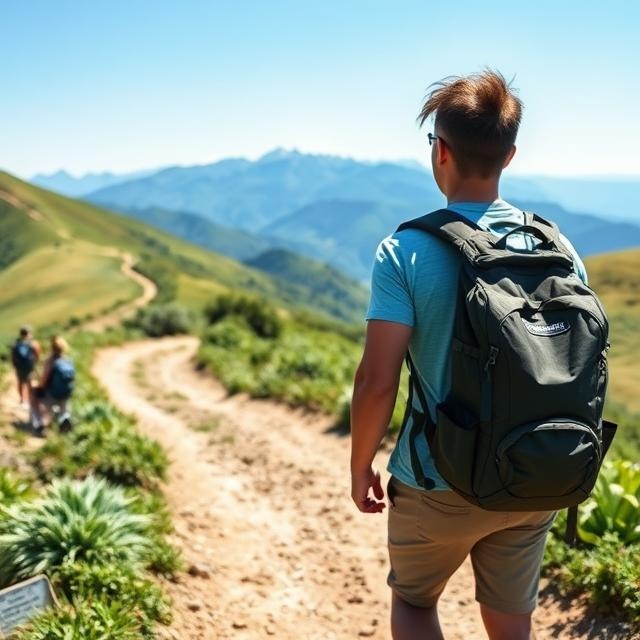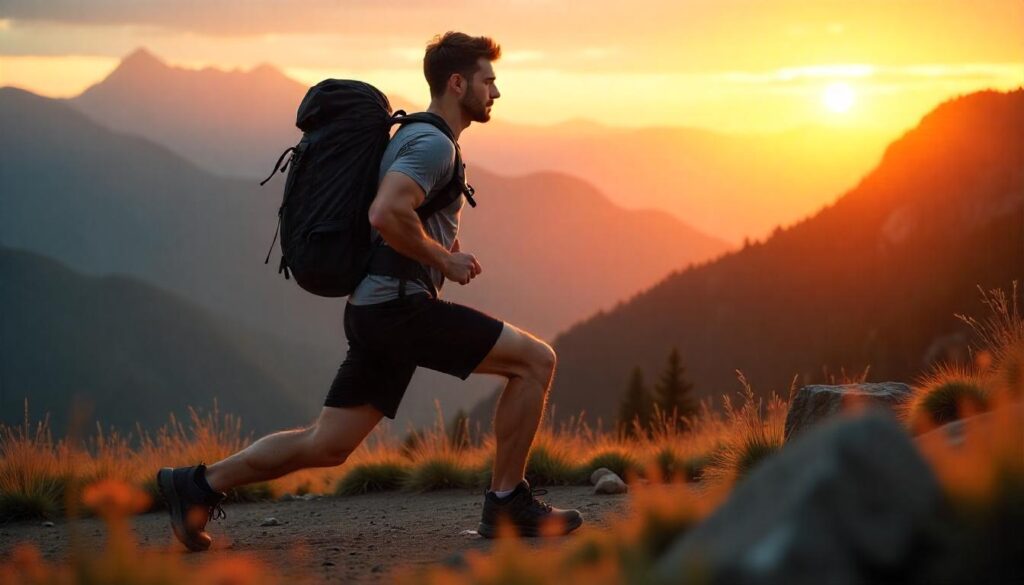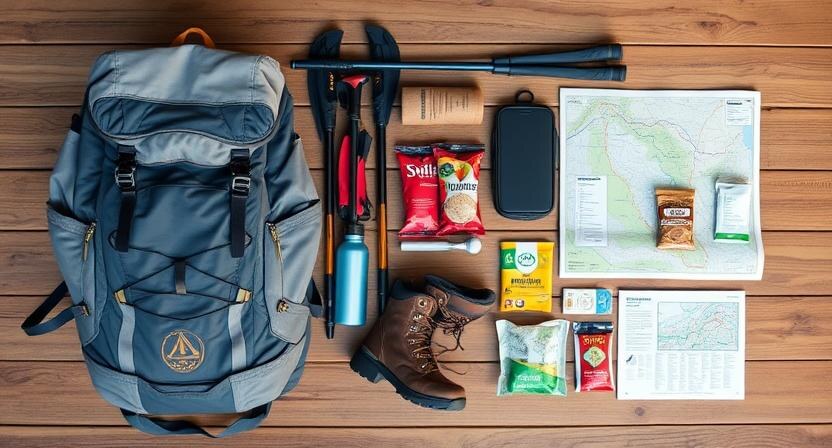
Packing the right gear for a hike is essential for safety, comfort, and enjoyment. Whether you are heading out for a short trail walk or a long backcountry trek, having the right essentials can make all the difference
Hiking exposes you to changing weather, uneven terrain, and unexpected challenges. Without the proper gear, you may face discomfort, dehydration, or even safety risks. Packing smart means bringing everything you need without carrying unnecessary weight.
On my first serious hike, I underestimated the importance of good gear. I wore regular sneakers, packed too little water, and forgot a light jacket. A few miles in, my feet hurt, I was thirsty, and the temperature dropped. I learned the hard way that proper planning can make or break a hike.
Why Packing Smart for a Hike is Essential
Packing the right gear for a hike is crucial for both comfort and safety. Whether you’re heading out for a short trail walk or embarking on a multi-day adventure, being well-prepared can make all the difference.
What to Bring on a Hike – The Importance of Proper Gear & Preparation
Carrying proper gear helps you stay hydrated, maintain energy levels, and handle any emergency situations that may arise. For instance, having a map and compass can prevent you from getting lost, while packing extra layers can protect you from sudden weather shifts.
Even a day hike requires careful planning. Essentials like water, snacks, a first-aid kit, and a navigation tool should always be in your pack. If you’re venturing into unfamiliar terrain, additional items such as a headlamp, emergency shelter, and fire-starting tools may also be necessary.
What Not to Bring on a Hike – Avoiding Unnecessary Weight & Safety Risks
Packing too much can make your hike unnecessarily difficult. Extra weight slows you down, increases fatigue, and can lead to joint strain. Some items to avoid bringing include:
- Excessive food & water: Carry only what’s needed based on hike length and weather conditions.
- Heavy gear: Choose lightweight alternatives for clothing, backpacks, and tools.
- Unnecessary gadgets: Large cameras, tablets, or extra electronics may add unnecessary weight.
- Cotton clothing: It absorbs moisture and dries slowly, increasing the risk of hypothermia in cold weather.
- Scented items: Perfumes or strong-smelling lotions can attract insects and wildlife.
How Different Hikes Require Different Gear – Short vs. Long vs. Multi-Day Hikes
Not all hikes require the same preparation. A short day hike needs minimal essentials, while a long or multi-day trek demands more careful planning. Here’s how the packing list differs:
- Short Hikes (1-4 hours): Water, snacks, navigation tools, sunscreen, and proper footwear.
- Long Day Hikes (4+ hours): Add extra water, more food, layers for changing weather, and a first-aid kit.
- Multi-Day Hikes: Requires overnight gear, including a sleeping bag, tent, cooking equipment, and additional food supplies.
Understanding these differences helps you pack efficiently and carry only what’s necessary for your hike type.
Essential Packing List – The Must-Have Hiking Gear
Knowing what to bring ensures comfort, safety, and preparedness. Below, we’ll break down the essential gear for different types of hikes and include a hiking gear comparison table to help you make informed choices.
Hiking Gear Comparison Table
| Gear Category | Day Hike (2-8 Hours) | Long Day Hike (8+ Hours) | Multi-Day / Thru-Hike |
| Backpack | 10-20L lightweight pack | 20-35L pack with hydration | 40-65L backpack for gear storage |
| Footwear | Trail runners or hiking shoes | Hiking boots or sturdy trail shoes | High-support boots for long treks |
| Clothing | Moisture-wicking layers | Extra insulation and rain gear | Layering system for all conditions |
| Navigation | Map, compass, or GPS app | GPS device + printed maps | GPS, detailed maps, and emergency beacon |
| Safety Gear | Basic first aid, whistle | First aid kit, multitool | Full emergency kit, bivy sack |
| Food & Water | 1-2L water, energy snacks | 2-3L water, meal for the hike | Water filtration, 3+ days of food |
Day Hike Packing List (2–8 Hours)

Even if you’re only hiking for a few hours, packing smart is key. Many beginners underestimate the importance of preparation, but weather conditions can change quickly, and trails can be more demanding than expected.
What to Bring on a Day Hike vs. a Short Hike
For short hikes (under 4 hours), you can get away with minimal gear: a small backpack, comfortable shoes, water, snacks, and a basic first aid kit. However, for longer day hikes (4-8 hours), you’ll need extra layers, more food, and navigation tools to ensure you stay on track.
What to Bring on a Trail Hike (Essentials for Marked Trails)
For well-marked trails, navigation might not be a major concern, but safety and comfort still matter:
- A map or a GPS hiking app for guidance
- Trekking poles if the trail has steep inclines
- Bug spray to keep insects away
- Extra socks in case of wet conditions
What to Bring on a Hike for Beginners (Beginner-Friendly Checklist)
New to hiking? Start with the basics to ensure a smooth experience:
- Lightweight backpack (10-20L)
- Water (at least 1.5L per person)
- Trail-friendly snacks like granola bars and nuts
- A simple first aid kit (bandages, antiseptic wipes, pain relievers)
- Comfortable hiking shoes with good grip
Long Day Hike (8+ Hours) – Packing Smart for Extended Treks

Longer hikes require additional preparation to maintain energy levels, stay safe, and adapt to changing conditions.
What to Bring on a Long Hike vs. a Long Day Hike
If you’re hiking for 8+ hours, you’ll need:
- More food and water (3L or more)
- A headlamp in case you return after dark
- A lightweight but durable backpack (20-35L)
- Navigation tools: map, compass, or GPS device
What to Bring on a Mountain Hike (Gear for Higher Elevations)
Mountain hikes can be unpredictable, so be prepared:
- Extra layers for colder temperatures at higher altitudes
- Trekking poles for stability on steep trails
- Sunglasses and sunscreen for UV protection at elevation
- A whistle and emergency blanket in case of emergencies
What to Bring on a Day Hike in the Mountains (Weather & Altitude Considerations)
Mountain weather changes rapidly, so pack accordingly:
- Gloves and a warm hat, even in summer
- Windproof and waterproof jacket
- Emergency shelter (light tarp or bivy sack)
Multi-Day & Thru-Hike Packing List

For overnight hikes, the right gear is crucial. You’ll need to carry all your supplies while keeping your pack as light as possible.
What to Bring on a Multi-Day Hike (Gear for Extended Backcountry Travel)
- Backpack (40-65L) to fit all essentials
- Extra socks and base layers for multiple days
- Navigation tools (GPS, detailed maps, compass)
- Bear-proof food storage if in bear country
What to Bring on a Thru-Hike (Lightweight Packing Tips for Long-Distance Hikes)
Thru-hikers must minimize pack weight while ensuring survival essentials:
- Ultralight sleeping bag and tent
- Lightweight clothing with quick-dry properties
- Portable solar charger for electronics
Food & Water – What to Eat & Drink on a Hike
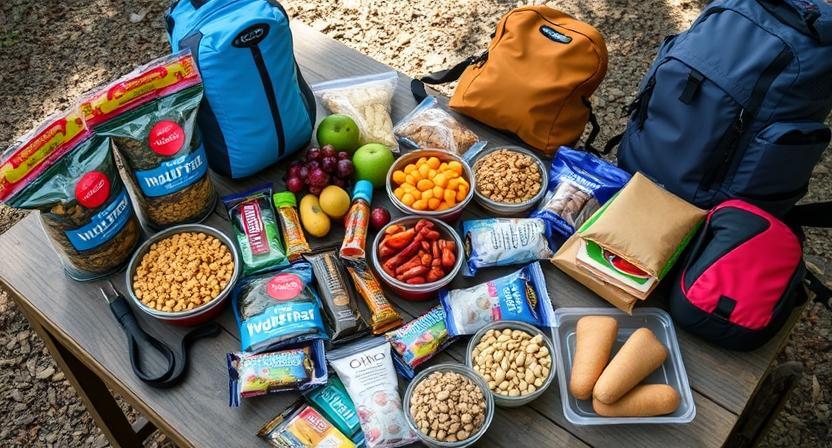
Eating the right foods and staying hydrated are essential for maintaining energy, endurance, and overall well-being while hiking. Whether you’re on a short trail hike, a long day trek, or a multi-day backpacking trip, packing nutrient-rich foods and a proper hydration system ensures a successful adventure. This guide covers everything you need to know about what food to bring on a hike, how much water you should carry, and the best ways to stay hydrated.
Food & Snacks for Hiking Comparison Table
| Category | Day Hike (2-8 Hours) | Long Day Hike (8+ Hours) | Multi-Day / Thru-Hike |
| Best Food Choices | Energy bars, trail mix, fresh fruits | Sandwiches, nut butter wraps, jerky | Dehydrated meals, oatmeal, rice, pasta |
| Ideal Snacks | Nuts, granola, dried fruit | Cheese, hard-boiled eggs, crackers | High-calorie snacks (nuts, chocolate, peanut butter) |
| Lunch Options | Protein bars, cheese sticks | Pre-packed sandwiches, tortillas with hummus | Freeze-dried meals, vacuum-sealed proteins |
| Water Needs | 1-2 liters per person | 2-3 liters per person | 3+ liters per day, plus filtration system |
What Food to Bring on a Hike (Balanced Nutrition for Energy)
The right food fuels your body and mind, keeping you energized, focused, and ready for any challenges on the trail.
What Food to Bring on a Hike (Essential Nutrition for Endurance)
Hiking burns a significant amount of calories, so your food should be nutrient-dense and easy to digest. The best hiking foods are:
- High in protein (helps with muscle recovery)
- Rich in complex carbs (provides sustained energy)
- Loaded with healthy fats (boosts endurance and keeps you full longer)
Great examples include: nuts, whole-grain crackers, jerky, nut butters, and dried fruits. Avoid foods that are too heavy or require refrigeration.
What Snacks to Bring on a Hike (Quick, Portable, & High-Energy Options)
Snacks are critical for keeping energy levels steady during a hike. The best snacks are lightweight, non-perishable, and easy to eat on the move:
- Trail mix (nuts, dried fruit, dark chocolate, seeds)
- Granola bars or protein bars
- Nut butters in single-serving packets
- Dried fruit (mango, apricots, bananas)
- Beef or turkey jerky
These options are nutrient-dense and provide quick fuel without weighing you down.
Multi-Day Hiking Food Planning
For multi-day and thru-hikes, proper food planning is essential. You’ll need to maximize calories while keeping weight minimal.
What Food to Bring on a 3-Day Hike (Backpacking-Friendly Meal Prep)
A 3-day hike requires food that is:
- Calorie-dense to sustain energy
- Lightweight & compact to reduce pack weight
- Non-perishable to stay fresh without refrigeration
Recommended meal plan:
- Breakfast: Instant oatmeal, powdered milk, nuts
- Lunch: Whole-wheat tortillas with peanut butter & honey
- Dinner: Freeze-dried meals or pasta with olive oil
- Snacks: Trail mix, protein bars, energy chews
What Food to Bring on a Long-Distance Hike (How to Sustain High Energy Over Days)
For hikes lasting multiple days or weeks, focus on:
- Dehydrated meals (lightweight, long shelf life)
- Powdered supplements (protein, greens, electrolytes)
- Nut butter packets for healthy fats
- Instant coffee or tea for morale boost
Pack food in vacuum-sealed bags to save space and reduce waste.
Hydration – How Much Water to Bring on a Hike
Staying hydrated is just as important as eating the right food. Dehydration can cause fatigue, dizziness, and severe health risks.
How Much Water to Bring on a Hike (Calculating Based on Hike Length & Weather)
The general rule is to drink half a liter (500mL) per hour of moderate hiking. However, factors like temperature, altitude, and exertion level affect water needs:
| Hike Type | Water Needed Per Person |
| Short Hike (2-4 hours) | 1-2 liters |
| Day Hike (4-8 hours) | 2-3 liters |
| Long Hike (8+ hours) | 3+ liters |
| Multi-Day Hike | 3 liters per day + filtration system |
Hiking in hot, dry climates requires more water. In high elevations, drink even when not thirsty to avoid altitude sickness.
Best Hydration Methods (Water Bottles vs. Reservoirs vs. Filtration Systems)
Choosing the right water system ensures you stay hydrated without carrying unnecessary weight:
- Water Bottles (Good for shorter hikes, easy to refill)
- Hydration Reservoirs (Hands-free drinking, ideal for long hikes)
- Water Purification (Tablets, pumps, or UV purifiers for multi-day hikes)
How to Purify Water on a Hike (Essential for Backcountry Trips)
For multi-day hikes or hikes with limited water access, carry a lightweight water filtration system:
- Water purification tablets (iodine/chlorine) – Compact & lightweight
- Pump filters – Remove bacteria and debris
- UV sterilizers – Kills viruses & bacteria in seconds
Always check trail maps for water sources before starting your hike.
Clothing – What to Wear & Bring on a Hike
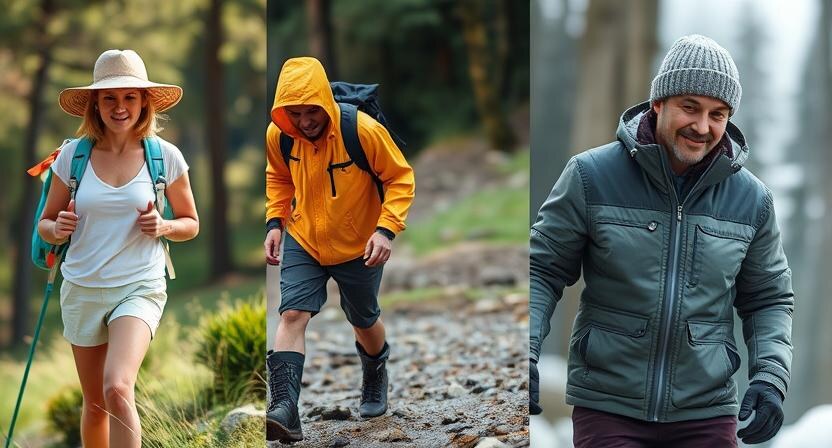
Whether you’re hiking in hot, cold, or rainy conditions, choosing the proper layering system and footwear will help regulate body temperature, wick away sweat, and protect against harsh weather conditions. Below, we’ll cover essential hiking clothing, weather-specific gear, and the best footwear options for different terrains.
Hiking Footwear Comparison Table
| Feature | Hiking Boots | Hiking Shoes | Hiking Sandals |
| Best For | Rocky, steep, rugged trails | Moderate trails, light hikes | Hot weather, water crossings |
| Ankle Support | High (Prevents ankle injuries) | Medium (Some protection) | Low (Minimal support) |
| Traction & Grip | Excellent (Deep lugs for grip) | Good (Traction on most surfaces) | Fair (Best for wet conditions) |
| Breathability | Low (Can be warm) | High (Breathable materials) | Very High (Open design) |
| Weight | Heavy (More fatigue) | Light (Easier to walk long distances) | Very Light (Best for casual hikes) |
| Durability | High (Lasts long in rough conditions) | Medium (Good for well-maintained trails) | Low (Wears out faster) |
Choosing the Right Hiking Clothes
What to Wear and Bring on a Hike (Layering Essentials for All Conditions)
Hiking clothing should be moisture-wicking, breathable, and weather-appropriate. The layering system helps hikers adapt to temperature changes:
- Base Layer (Moisture Control) – A lightweight, sweat-wicking shirt made of merino wool or synthetic fabric keeps your body dry. Avoid cotton, as it retains moisture and can cause hypothermia in cold conditions.
- Mid Layer (Insulation) – A fleece jacket or lightweight puffer traps heat and keeps you warm. Choose synthetic insulation for wet conditions or down insulation for dry, cold weather.
- Outer Layer (Weather Protection) – A waterproof and windproof shell protects against rain, wind, and snow. Look for Gore-Tex or other breathable waterproof materials.
Hiking pants should be quick-drying and flexible, such as nylon or polyester blends. Convertible pants (zip-offs) are great for changing weather conditions.
What to Bring on a Hike in Different Weather (Hot, Cold, Rainy Hikes)
Different climates require specific hiking gear to stay comfortable and safe:
- Hot Weather: Wear lightweight, breathable fabrics with built-in UV protection. A wide-brimmed hat, sunglasses, and sunscreen help protect against sunburn. Avoid dark colors as they absorb heat.
- Cold Weather: Insulated layers are essential. Pack thermal base layers, a down or synthetic jacket, gloves, and a wool beanie to stay warm.
- Rainy Weather: A waterproof jacket, rain pants, and gaiters keep you dry. Wet clothing lowers body temperature and increases the risk of hypothermia.
Specialized Hiking Gear for Different Conditions
Some hikes require specific gear based on elevation, terrain, and climate. Below are the must-have essentials for different conditions.
Weather-Based Packing Table
| Hiking Environment | Essential Gear |
| Mountain / High Elevation | Trekking poles, altitude sickness medication, warm layers, water filtration system |
| 14er (14,000 ft Peak) | Micro spikes, GPS device, extra water, oxygen canister (if needed) |
| Hiking in the Woods | Bug spray, navigation tools, bear spray, long-sleeved clothing |
| Winter Hike | Insulated boots, waterproof gloves, emergency shelter, thermal clothing |
| Night Hike | Headlamp, extra batteries, reflective gear, emergency whistle |
What to Bring on a Mountain or Elevation Hike
What to Bring on a Hike in the Mountains (Weather, Altitude & Rough Terrain Gear)
Mountain hikes come with rapid weather changes, steep inclines, and unpredictable terrain. Being prepared with the right gear is crucial:
- Trekking poles help reduce impact on knees and improve balance.
- Insulated, waterproof layers keep you warm and dry.
- Sunglasses with UV protection prevent snow blindness at higher elevations.
- A water filtration system ensures access to clean drinking water.
What to Bring on a 14er Hike (High-Altitude Essentials for Peaks Over 14,000 Feet)
14er hikes are physically demanding due to thin air and challenging climbs. Pack:
- Altitude sickness medication (consult a doctor before use).
- Extra water and electrolyte tablets to prevent dehydration.
- Micro spikes for icy or slippery sections.
- High-calorie snacks to sustain energy levels.
What to Bring on a Hike in the Woods (Navigation, Bug Protection, and Safety Tips)
Dense forests can be disorienting, so navigation is key. Essentials include:
- GPS device, map, and compass to avoid getting lost.
- Bug spray and insect-repellent clothing to prevent bites.
- Bear spray (if in bear territory) and a bear-proof food container.
Safety Essentials for Different Environments
What to Bring on a Winter Hike (Cold-Weather Survival Tips & Gear)
Winter hiking presents frostbite risks, freezing temperatures, and slippery trails. Pack:
- Insulated boots with waterproof lining for warmth and traction.
- Thermal gloves and a windproof hat to prevent heat loss.
- Emergency bivy sack or sleeping bag in case of unexpected overnight stays.
- Hand warmers and extra food to maintain body heat.
What to Bring on a Night Hike (Lighting, Safety, and Nighttime Navigation)
Hiking at night reduces visibility and increases safety risks. Must-have gear includes:
- A headlamp with extra batteries (red-light mode helps preserve night vision).
- Reflective gear and glow sticks for visibility.
- Emergency whistle and personal alarm in case of distress.
- A buddy system or group hiking for added safety.
Hiking Safety & Emergency Essentials
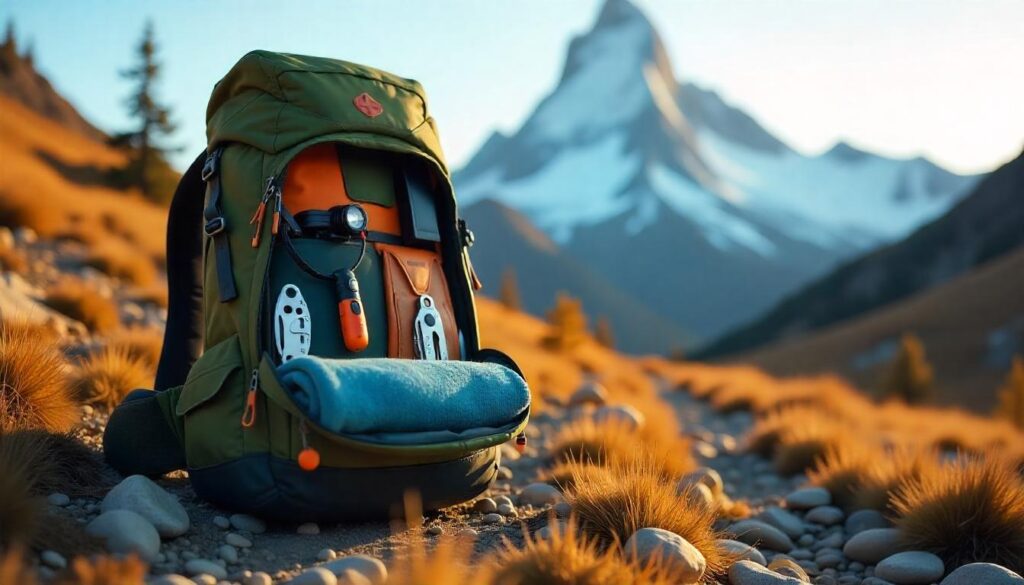
Hiking is an exciting and rewarding outdoor activity, but unexpected situations can arise at any time. Whether you’re dealing with a sudden weather change, a twisted ankle, or getting lost on the trail, having the right safety and emergency essentials can make a critical difference. Proper navigation tools, first aid kits, and emergency preparedness ensure that hikers are ready for any challenge that may come their way. Below, we’ll break down must-have safety gear, navigation essentials, and first aid items to carry on every hike.
Emergency & Safety Gear Table
| Item | Purpose | Recommended For |
| Map & Compass | Reliable navigation in areas with no cell service | All hikes, especially backcountry |
| GPS Device | Digital navigation with real-time tracking | Remote hikes, thru-hiking |
| Fire Starter | Helps in emergency warmth and survival situations | Cold-weather hikes, overnight trips |
| First Aid Kit | Treats minor injuries, blisters, and emergencies | All hikes, especially long treks |
| Emergency Whistle | Alerts rescuers if lost or injured | Solo hikers, deep wilderness |
| Space Blanket | Retains body heat in cold conditions | Winter hikes, emergencies |
| Multi-Tool or Knife | Useful for repairs, food prep, and emergencies | Backpacking, long hikes |
Navigation & First Aid

Ten Essentials for Hiking (Navigation, Fire-Starting, First Aid, and Emergency Tools)
The “Ten Essentials” is a must-follow checklist for every hiker, ensuring safety and preparedness in case of an emergency. These include:
- Navigation – Carry a topographic map, compass, or GPS device to prevent getting lost.
- Headlamp & Extra Batteries – A must for early morning or night hikes.
- Sun Protection – Sunglasses, sunscreen, and a hat to protect from UV rays.
- First Aid Kit – Bandages, antiseptic wipes, pain relievers, and blister treatment.
- Knife or Multi-Tool – Useful for gear repairs, food prep, and emergencies.
- Fire Starter – Waterproof matches or a lighter for warmth and survival.
- Emergency Shelter – A space blanket or bivy sack for unexpected overnight stays.
- Extra Food – High-calorie snacks and emergency rations in case of delays.
- Extra Water & Filtration – Bring more water than needed and have a purification method.
- Extra Clothing – Weather-appropriate layers, including rain gear and gloves.
What to Bring on a Hike Reddit Recommends (Insights from Real Hikers)
Online hiking communities like Reddit’s r/hiking provide real-world insights on gear and trail experiences. Common recommendations include:
- Trekking poles to reduce knee strain on steep trails.
- Duct tape or repair kits for fixing broken gear.
- Bear spray for wildlife encounters in certain areas.
- Satellite communicator (e.g., Garmin inReach) for emergencies where cell service is unavailable.
Safety for Different Hike Types
What to Bring on a Hike for Beginners (Starter Gear & Safety Precautions)
Beginner hikers should start with well-marked, easy-to-follow trails and carry basic hiking gear for safety. Essentials include:
- Comfortable hiking shoes or boots for support and traction.
- A small backpack with water, snacks, navigation tools, and a rain jacket.
- A charged phone with GPS apps.
- First aid essentials, including blister treatment.
- Knowledge of trail rules and Leave No Trace principles to protect nature.
What to Bring on a Trail Hike (Essentials for Well-Marked vs. Unmarked Trails)
Trail hikes vary in difficulty, with marked trails being easier to navigate while unmarked trails require more navigation skills and preparation.
- For well-marked trails: A map, plenty of water, and weather-appropriate layers will suffice.
- For unmarked trails: Bring a compass, detailed map, extra food, and a personal locator beacon (PLB) in case of emergencies.
Conclusion – Final Packing Tips for a Safe & Fun Hike

Proper preparation is key to ensuring a safe, enjoyable, and memorable hiking experience. Whether you’re heading out for a short day hike, a mountain trek, or a multi-day adventure, packing smart will enhance your journey and keep you prepared for any situation.
Quick Recap of What to Bring with You on a Hike (Essentials & Checklists)
- Navigation tools → Map, compass, GPS app.
- Proper clothing & footwear → Layered clothing, waterproof jacket, sturdy hiking shoes.
- Food & hydration → High-energy snacks, extra water, and a filtration system.
- First aid & safety gear → Bandages, blister treatment, emergency whistle.
- Emergency tools → Fire starter, space blanket, multi-tool, flashlight.
Lightweight Packing Tips (How to Pack Smart & Avoid Unnecessary Weight)
- Choose multi-purpose gear → A lightweight rain jacket that doubles as a windbreaker.
- Limit bulky food packaging → Use resealable bags to pack snacks efficiently.
- Invest in ultralight gear → Lighter backpacks, compact sleeping bags, and inflatable pads reduce weight.
- Distribute weight properly → Keep heavy items close to your back for better balance.
By packing efficiently and bringing only the essentials, you’ll stay safe, move faster, and enjoy your hike without unnecessary strain. Now, grab your gear, plan your route, and hit the trail with confidence!
Ethan Marlowe is an experienced hiker and outdoor gear specialist based in Colorado. With over 7 years of hands-on experience trekking through the Rockies, Pacific Northwest, and East Coast trails, he delivers practical advice, expert gear reviews, and survival insights. His goal is to help hikers of all levels make smarter decisions on and off the trail.

